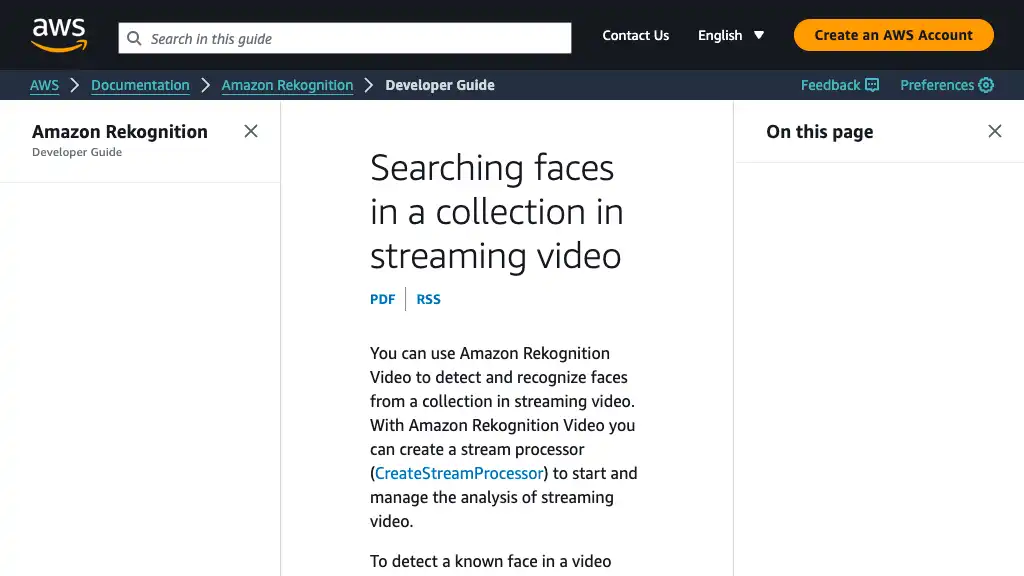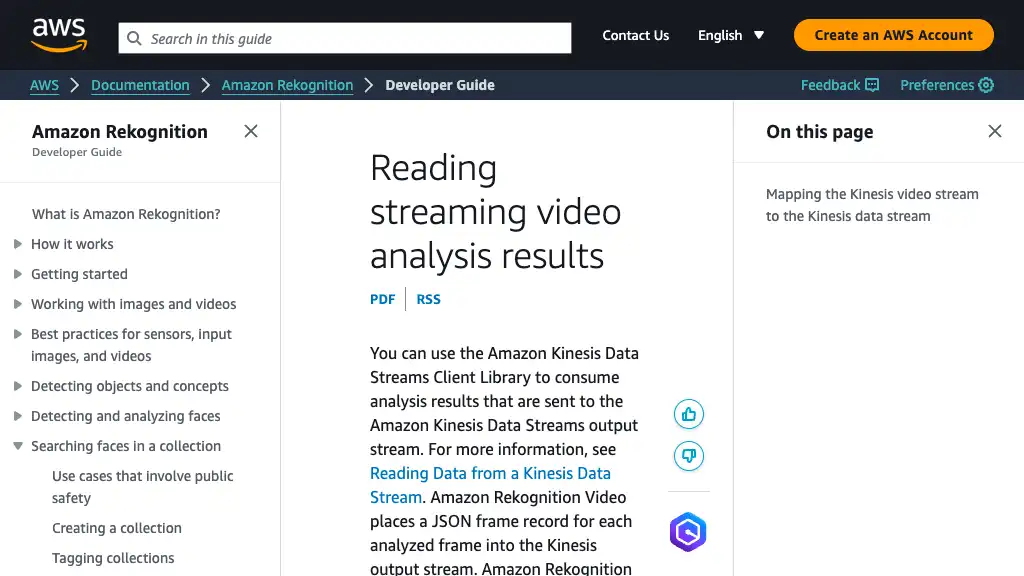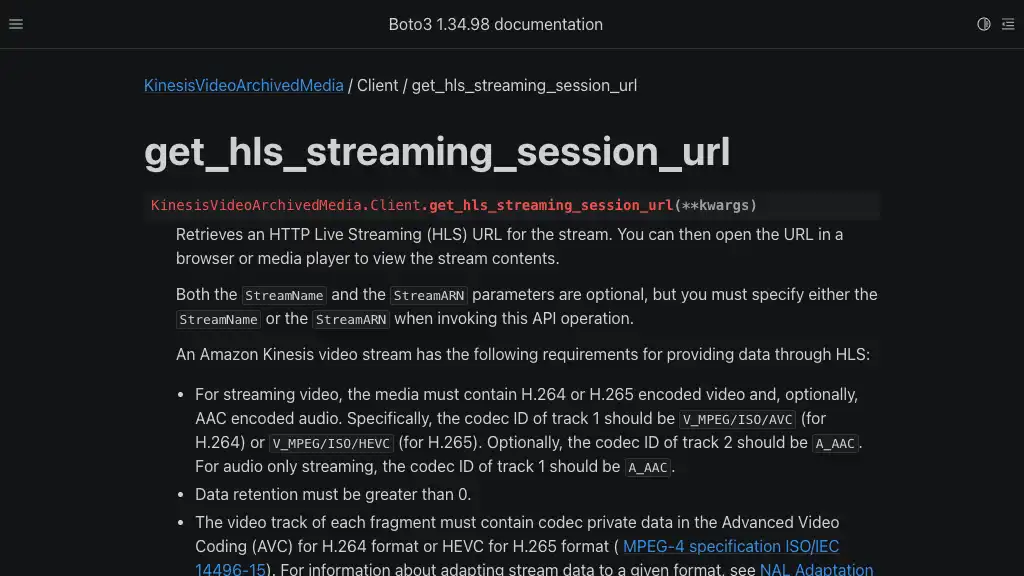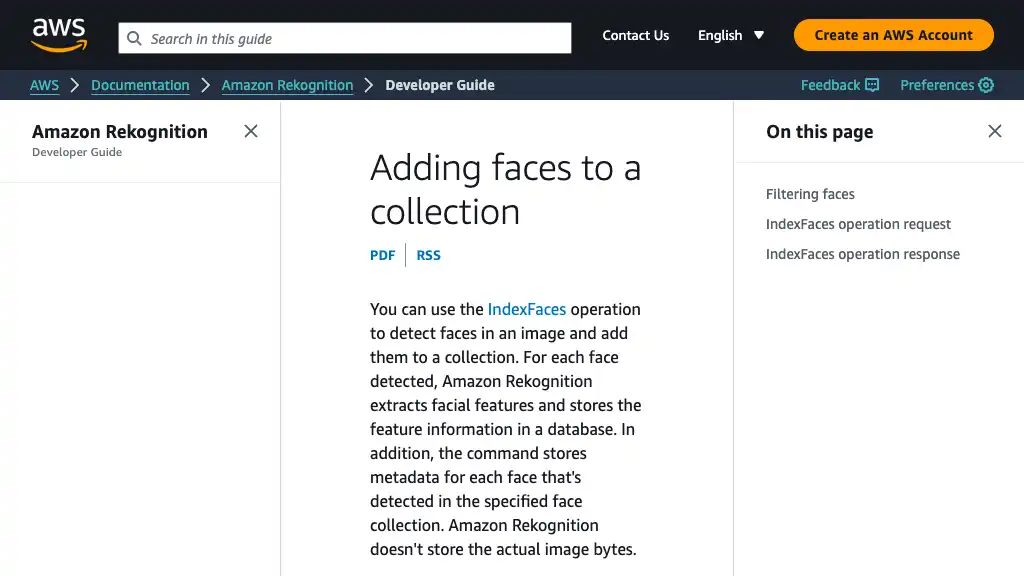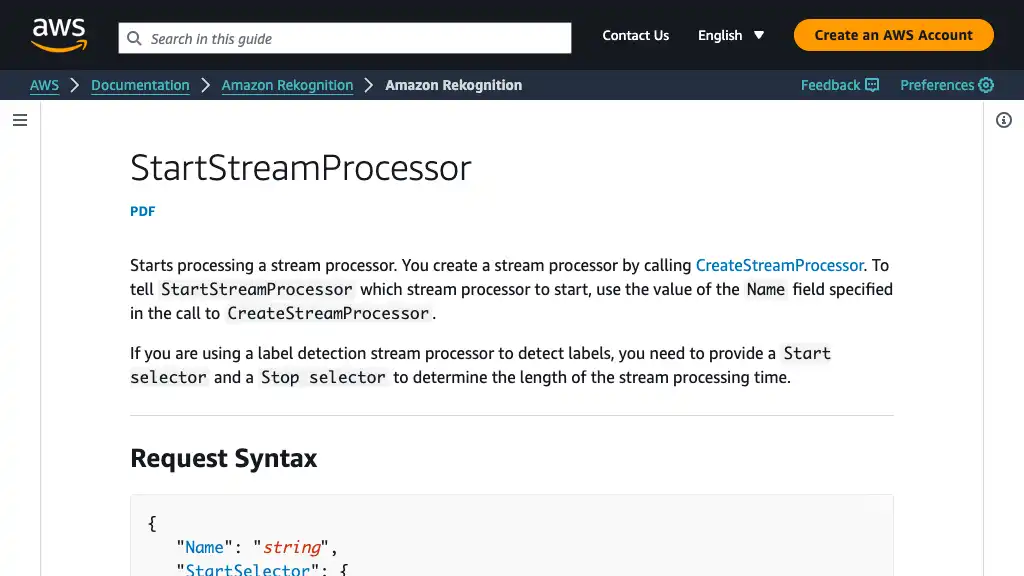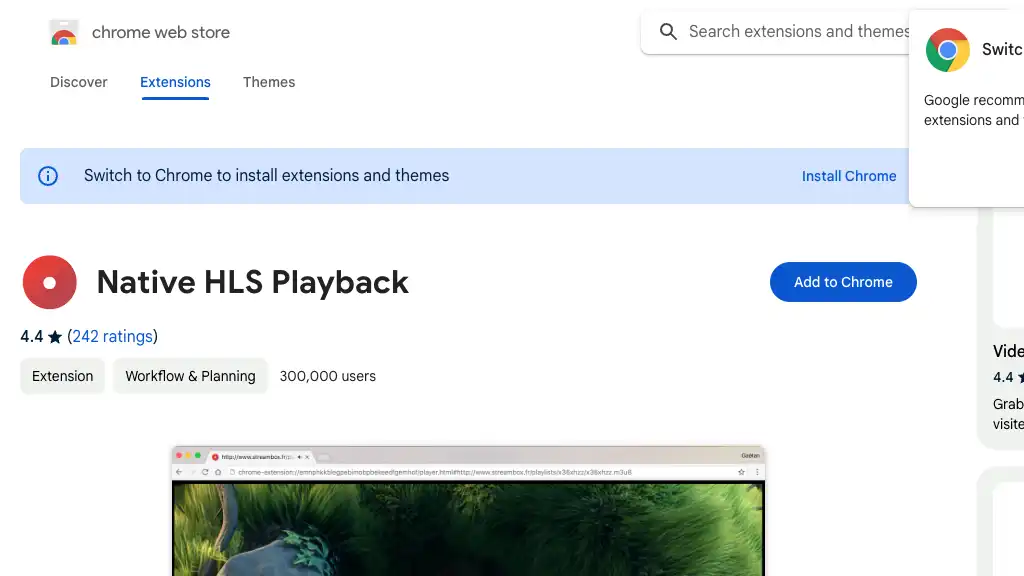Implementing Face Detector on USB Camera Connected to Raspberry Pi using Kinesis Video Streams and Rekognition Video

Using Kinesis Video Streams and Rekognition Video, I implemented a face detector on a USB camera connected to Raspberry Pi. Let me show you how to implement.
Overview
Prerequisites
Video Producer
In this post, the following is used as a video producer:
- Raspberry Pi 4B with 4GB RAM
- Ubuntu 23.10 (installed using Raspberry Pi Imager)
- USB Camera
- GStreamer
AWS Resources
This post uses the following:
- AWS SAM CLI
- Python 3.11
Creating SAM Application
You can pull an example code used in this post from my GitHub repository.
Directory Structure
/
|-- src/
| |-- app.py
| `-- requirements.txt
|-- samconfig.toml
`-- template.yaml
AWS SAM Template
AWSTemplateFormatVersion: 2010-09-09
Transform: AWS::Serverless-2016-10-31
Description: face-detector-using-kinesis-video-streams
Resources:
Function:
Type: AWS::Serverless::Function
Properties:
FunctionName: face-detector-function
CodeUri: src/
Handler: app.lambda_handler
Runtime: python3.11
Architectures:
- arm64
Timeout: 3
MemorySize: 128
Role: !GetAtt FunctionIAMRole.Arn
Events:
KinesisEvent:
Type: Kinesis
Properties:
Stream: !GetAtt KinesisStream.Arn
MaximumBatchingWindowInSeconds: 10
MaximumRetryAttempts: 3
StartingPosition: LATEST
FunctionIAMRole:
Type: AWS::IAM::Role
Properties:
RoleName: face-detector-function-role
AssumeRolePolicyDocument:
Version: 2012-10-17
Statement:
- Effect: Allow
Principal:
Service: lambda.amazonaws.com
Action: sts:AssumeRole
ManagedPolicyArns:
- arn:aws:iam::aws:policy/service-role/AWSLambdaBasicExecutionRole
- arn:aws:iam::aws:policy/service-role/AWSLambdaKinesisExecutionRole
Policies:
- PolicyName: policy
PolicyDocument:
Version: 2012-10-17
Statement:
- Effect: Allow
Action:
- kinesisvideo:GetHLSStreamingSessionURL
- kinesisvideo:GetDataEndpoint
Resource: !GetAtt KinesisVideoStream.Arn
KinesisVideoStream:
Type: AWS::KinesisVideo::Stream
Properties:
Name: face-detector-kinesis-video-stream
DataRetentionInHours: 24
RekognitionCollection:
Type: AWS::Rekognition::Collection
Properties:
CollectionId: FaceCollection
RekognitionStreamProcessor:
Type: AWS::Rekognition::StreamProcessor
Properties:
Name: face-detector-rekognition-stream-processor
KinesisVideoStream:
Arn: !GetAtt KinesisVideoStream.Arn
KinesisDataStream:
Arn: !GetAtt KinesisStream.Arn
RoleArn: !GetAtt RekognitionStreamProcessorIAMRole.Arn
FaceSearchSettings:
CollectionId: !Ref RekognitionCollection
FaceMatchThreshold: 80
DataSharingPreference:
OptIn: false
KinesisStream:
Type: AWS::Kinesis::Stream
Properties:
Name: face-detector-kinesis-stream
StreamModeDetails:
StreamMode: ON_DEMAND
RekognitionStreamProcessorIAMRole:
Type: AWS::IAM::Role
Properties:
RoleName: face-detector-rekognition-stream-processor-role
AssumeRolePolicyDocument:
Version: 2012-10-17
Statement:
- Effect: Allow
Principal:
Service: rekognition.amazonaws.com
Action: sts:AssumeRole
ManagedPolicyArns:
- arn:aws:iam::aws:policy/service-role/AmazonRekognitionServiceRole
Policies:
- PolicyName: policy
PolicyDocument:
Version: 2012-10-17
Statement:
- Effect: Allow
Action:
- kinesis:PutRecord
- kinesis:PutRecords
Resource:
- !GetAtt KinesisStream.Arn
Python Script
requirements.txt
Leave it empty.
app.py
The Rekognition Video stream processor streams detected faces data to the Kinesis Data Stream, and it can be obtained as Base64 string (line 18). For information about the data structure, please refer to the official documentation.
The Lambda function generates an HLS url using KinesisVideoArchivedMedia#get_hls_streaming_session_url API (line 52-64).
import base64
import json
import logging
from datetime import datetime, timedelta, timezone
from functools import cache
import boto3
JST = timezone(timedelta(hours=9))
kvs_client = boto3.client('kinesisvideo')
logger = logging.getLogger(__name__)
logger.setLevel(logging.INFO)
def lambda_handler(event: dict, context: dict) -> dict:
for record in event['Records']:
base64_data = record['kinesis']['data']
stream_processor_event = json.loads(base64.b64decode(base64_data).decode())
# For more information the result, please refer to https://docs.aws.amazon.com/rekognition/latest/dg/streaming-video-kinesis-output.html
if not stream_processor_event['FaceSearchResponse']:
continue
logger.info(stream_processor_event)
url = get_hls_streaming_session_url(stream_processor_event)
logger.info(url)
return {
'statusCode': 200,
}
@cache
def get_kvs_am_client(api_name: str, stream_arn: str):
# See https://boto3.amazonaws.com/v1/documentation/api/latest/reference/services/kinesisvideo/client/get_data_endpoint.html
endpoint = kvs_client.get_data_endpoint(
APIName=api_name.upper(),
StreamARN=stream_arn
)['DataEndpoint']
return boto3.client('kinesis-video-archived-media', endpoint_url=endpoint)
def get_hls_streaming_session_url(stream_processor_event: dict) -> str:
# See https://boto3.amazonaws.com/v1/documentation/api/latest/reference/services/kinesis-video-archived-media/client/get_hls_streaming_session_url.html
kinesis_video = stream_processor_event['InputInformation']['KinesisVideo']
stream_arn = kinesis_video['StreamArn']
kvs_am_client = get_kvs_am_client('get_hls_streaming_session_url', stream_arn)
start_timestamp = datetime.fromtimestamp(kinesis_video['ServerTimestamp'], JST)
end_timestamp = datetime.fromtimestamp(kinesis_video['ServerTimestamp'], JST) + timedelta(minutes=1)
return kvs_am_client.get_hls_streaming_session_url(
StreamARN=stream_arn,
PlaybackMode='ON_DEMAND',
HLSFragmentSelector={
'FragmentSelectorType': 'SERVER_TIMESTAMP',
'TimestampRange': {
'StartTimestamp': start_timestamp,
'EndTimestamp': end_timestamp,
},
},
ContainerFormat='FRAGMENTED_MP4',
Expires=300,
)['HLSStreamingSessionURL']
Build and Deploy
Build and deploy with the following command.
sam build
sam deploy
Indexing Faces
Index faces which you want to detect by the USB camera. Before running the following command, replace placeholders <YOUR_BUCKET>, <YOUR_OBJECT> and <PERSON_ID> with your actual values.
aws rekognition index-faces \
--image '{"S3Object": {"Bucket": "<YOUR_BUCKET>", "Name": "<YOUR_OBJECT>"}}' \
--collection-id FaceCollection \
--external-image-id <PERSON_ID>
Rekognition does not store actual images in collections.
For each face detected, Amazon Rekognition extracts facial features and stores the feature information in a database. In addition, the command stores metadata for each face that’s detected in the specified face collection. Amazon Rekognition doesn’t store the actual image bytes.
Setting up Video Producer
In this post, a Raspberry Pi 4B with 4GB RAM, Ubuntu 23.10 installed, is used as a video producer.
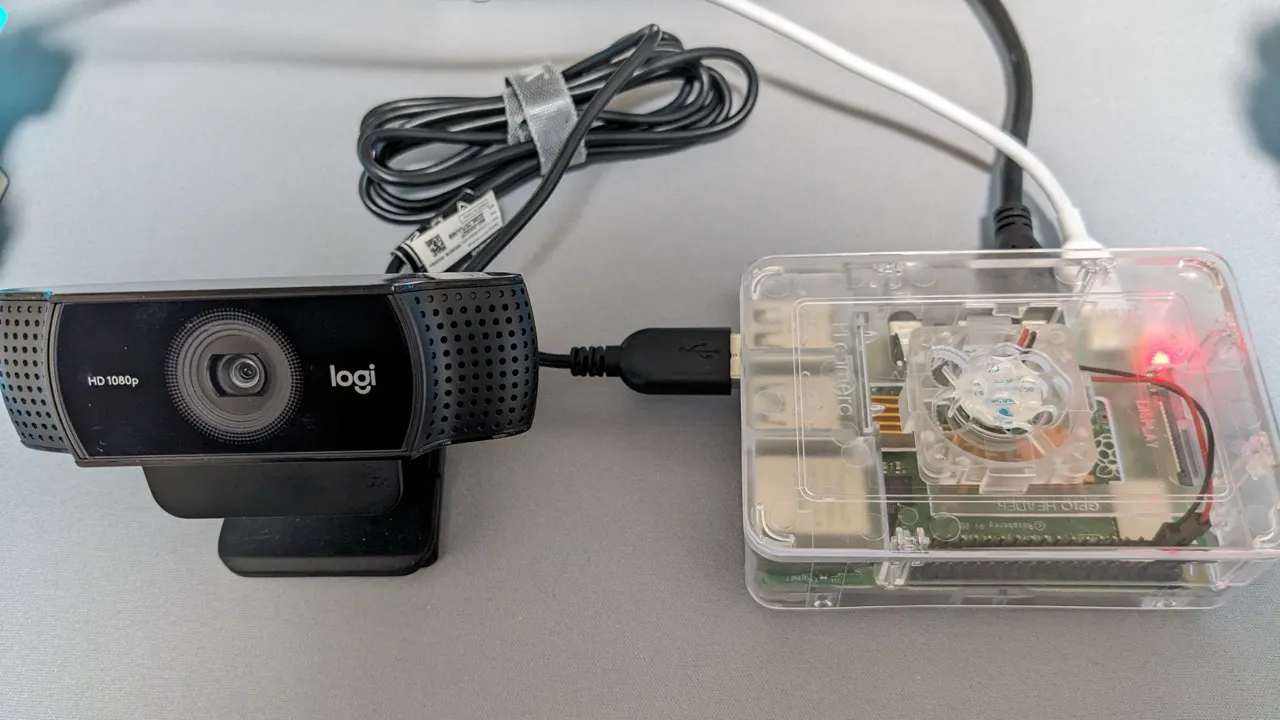
Build the AWS-provided Amazon Kinesis Video Streams CPP Producer, GStreamer Plugin and JNI.
Although AWS provides Docker images containing the GStreamer plugin, these did not work on my Raspberry Pi.
Building GStreamer Plugin
Run the following command to build the plugin. According to your machine specs, it may take about 20 minutes or more.
sudo apt update
sudo apt upgrade
sudo apt install \
make \
cmake \
build-essential \
m4 \
autoconf \
default-jdk
sudo apt install \
libssl-dev \
libcurl4-openssl-dev \
liblog4cplus-dev \
libgstreamer1.0-dev \
libgstreamer-plugins-base1.0-dev \
gstreamer1.0-plugins-base-apps \
gstreamer1.0-plugins-bad \
gstreamer1.0-plugins-good \
gstreamer1.0-plugins-ugly \
gstreamer1.0-tools
git clone https://github.com/awslabs/amazon-kinesis-video-streams-producer-sdk-cpp.git
mkdir -p amazon-kinesis-video-streams-producer-sdk-cpp/build
cd amazon-kinesis-video-streams-producer-sdk-cpp/build
sudo cmake .. -DBUILD_GSTREAMER_PLUGIN=ON -DBUILD_JNI=TRUE
sudo make
Check the building result with the following command.
cd ~/amazon-kinesis-video-streams-producer-sdk-cpp
export GST_PLUGIN_PATH=`pwd`/build
export LD_LIBRARY_PATH=`pwd`/open-source/local/lib
gst-inspect-1.0 kvssink
The below should be displayed.
Factory Details:
Rank primary + 10 (266)
Long-name KVS Sink
Klass Sink/Video/Network
Description GStreamer AWS KVS plugin
Author AWS KVS <[email protected]>
...
For next startup, it is useful to add export <XXX_PATH> to your ~/.profile.
echo "" >> ~/.profile
echo "# GStreamer" >> ~/.profile
echo "export GST_PLUGIN_PATH=$GST_PLUGIN_PATH" >> ~/.profile
echo "export LD_LIBRARY_PATH=$LD_LIBRARY_PATH" >> ~/.profile
Running GStreamer
Connect the USB camera to your device, and run the following command.
gst-launch-1.0 -v v4l2src device=/dev/video0 \
! videoconvert \
! video/x-raw,format=I420,width=320,height=240,framerate=5/1 \
! x264enc bframes=0 key-int-max=45 bitrate=500 tune=zerolatency \
! video/x-h264,stream-format=avc,alignment=au \
! kvssink stream-name=<KINESIS_VIDEO_STREAM_NAME> storage-size=128 access-key="<YOUR_ACCESS_KEY>" secret-key="<YOUR_SECRET_KEY>" aws-region="<YOUR_AWS_REGION>"
You can check the live streaming video from the camera in the Kinesis Video Streams management console.

Testing
Starting Rekognition Video stream processor
Start the Rekognition Video stream processor. This will subscribe the Kinesis Video Stream, detect faces using face collection, and stream the result to the Kinesis Data Stream.
aws rekognition start-stream-processor --name face-detector-rekognition-stream-processor
Check that the stream processor status is "Status": "RUNNING".
aws rekognition describe-stream-processor --name face-detector-rekognition-stream-processor | grep "Status"
Capturing Faces
After capturing faces by the USB camera, the video data will be processed by the following order:
- The video data will be streamed to the Kinesis Video Stream.
- The streamed data will be processed by the Rekognition Video stream processor.
- The stream processor results will be streamed to the Kinesis Data Stream.
- HLS urls will be generated by the Lambda function.
Check the Lambda function log records by the following command.
sam logs -n Function --stack-name face-detector-using-kinesis-video-streams --tail
The log records include the stream processor event data like the following.
{
"InputInformation": {
"KinesisVideo": {
"StreamArn": "arn:aws:kinesisvideo:<AWS_REGION>:<AWS_ACCOUNT_ID>:stream/face-detector-kinesis-video-stream/xxxxxxxxxxxxx",
"FragmentNumber": "91343852333181501717324262640137742175000164731",
"ServerTimestamp": 1702208586.022,
"ProducerTimestamp": 1702208585.699,
"FrameOffsetInSeconds": 0.0,
}
},
"StreamProcessorInformation": {"Status": "RUNNING"},
"FaceSearchResponse": [
{
"DetectedFace": {
"BoundingBox": {
"Height": 0.4744676,
"Width": 0.29107505,
"Left": 0.33036956,
"Top": 0.19599175,
},
"Confidence": 99.99677,
"Landmarks": [
{"X": 0.41322955, "Y": 0.33761832, "Type": "eyeLeft"},
{"X": 0.54405355, "Y": 0.34024307, "Type": "eyeRight"},
{"X": 0.424819, "Y": 0.5417343, "Type": "mouthLeft"},
{"X": 0.5342691, "Y": 0.54362005, "Type": "mouthRight"},
{"X": 0.48934412, "Y": 0.43806323, "Type": "nose"},
],
"Pose": {"Pitch": 5.547308, "Roll": 0.85795176, "Yaw": 4.76913},
"Quality": {"Brightness": 57.938313, "Sharpness": 46.0298},
},
"MatchedFaces": [
{
"Similarity": 99.986176,
"Face": {
"BoundingBox": {
"Height": 0.417963,
"Width": 0.406223,
"Left": 0.28826,
"Top": 0.242463,
},
"FaceId": "xxxxxxxx-xxxx-xxxx-xxxx-xxxxxxxxxxxx",
"Confidence": 99.996605,
"ImageId": "xxxxxxxx-xxxx-xxxx-xxxx-xxxxxxxxxxxx",
"ExternalImageId": "iwasa",
},
}
],
}
],
}
You can also find the HLS url within the log records like the following.
https://x-xxxxxxxx.kinesisvideo.<AWS_REGION>.amazonaws.com/hls/v1/getHLSMasterPlaylist.m3u8?SessionToken=xxxxxxxxxx
To watch the on-demand video, open the url using Safari or Edge.
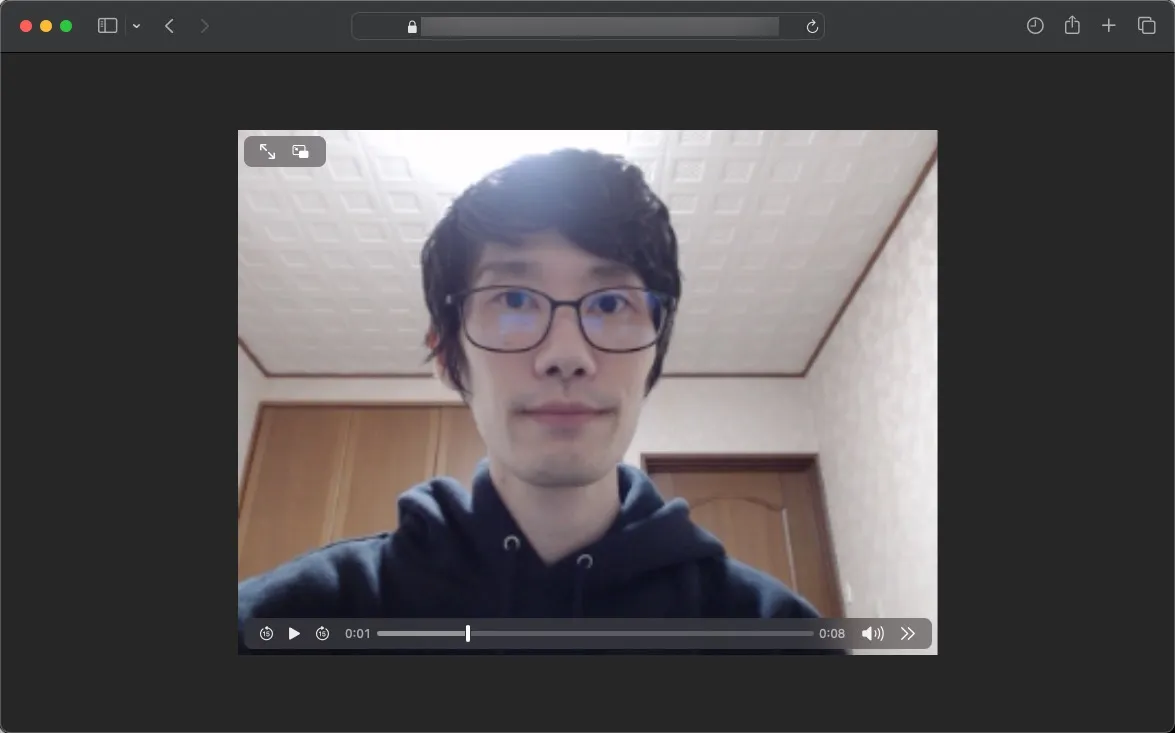
Cleaning Up
Clean up the provisioned AWS resources with the following command.
aws rekognition stop-stream-processor --name face-detector-rekognition-stream-processor
sam delete
Pricing
Here is an example simulation based on the following condition.
- AWS region
ap-northeast-1will be used. - The USB camera will always stream video data to the Kinesis Video Stream. Its size will be about 1GB per day and stored during one day.
- The Rekognition Video stream processor will always analyze the Kinesis Video Stream.
- The face collection has 10 facial data.
- The Kinesis Data Stream will always provision one shard.
- The Lambda (Arm/128MB) function will be invoked every seconds. Billable duration will be about 100ms.
- Users will watch on-demand video using HLS urls one hour in one day.
Kinesis Video Streams
| Item | Price |
|---|---|
| Data Ingested into Kinesis Video Streams (per GB data ingested) | $0.01097 |
| Data Consumed from Kinesis Video Streams (per GB data egressed) | $0.01097 |
| Data Consumed from Kinesis Video Streams using HLS (per GB data egressed) | $0.01536 |
| Data Stored in Kinesis Video Streams (per GB-Month data stored) | $0.025 |
Simulation
| Item | Expression | Price |
|---|---|---|
| Data Ingested | 1 GB * 31 days * $0.01097 | $0.34007 |
| Data Consumed | 1 GB * 31 days * $0.01097 | $0.34007 |
| Data Consumed using HLS | 1 hour * 31 days * $0.01536 | $0.47616 |
| Data Stored | 1 GB * 31 days * $0.025 | $0.775 |
| Total | - | $1.9 |
Rekognition Video
| Item | Price |
|---|---|
| Face Vector Storage | $0.000013/face metadata per month |
| Face Search | $0.15/min |
Simulation
| Item | Expression | Price |
|---|---|---|
| Face Vector Storage | 10 faces * $0.000013 | $0.00013 |
| Face Search | 60 minutes * 24 hours * 31 days * $0.15 | $6,696 |
| Total | - | $6,696 |
Kinesis Data Streams
| Item | Price |
|---|---|
| Shard Hour (1MB/second ingress, 2MB/second egress) | $0.0195 |
| PUT Payload Units, per 1,000,000 units | $0.0215 |
Simulation
| Item | Expression | Price |
|---|---|---|
| Shard Hour | 1 shard * 24 hours * 31 days * $0.0195 | $14.508 |
| PUT Payload Units | 1 unit * 60 seconds * 60 minutes * 24 hours * 31 days * 0.0215 / 1000000 | $0.0575856 |
| Total | - | $14.6 |
Lambda
| Item | Price |
|---|---|
| Price per 1ms (128MB) | $0.0000000017 |
Simulation
| Item | Expression | Price |
|---|---|---|
| Price per 1ms | 100ms * 60 seconds * 60 minutes * 24 hours * 31 days * $0.0000000017 | $0.455328 |
| Total | - | $0.5 |
